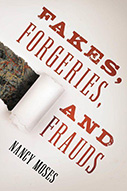Fakes, Forgeries, And Frauds

Author: Nancy Moses
Publisher: Lanham, MD: Rowman & Littlefield, 2020. 216p.
Reviewer: Louise Nicholas (Grove) | September 2021
Fakes, Forgeries, and Frauds is a 2020 publication focusing on art and artefacts that have questions around their authenticity, and the impact these objects and stories have on society at large. There is a great deal of money in the art market, so it is hardly surprising that enterprising criminals try to cash in on this by faking their way to the bank. It is precisely this phenomenon that Moses takes as her starting point in the text. By detailing nine case studies where authenticity is in question, Moses draws the reader into the intricacies of each case.
Beginning with a brief introduction of the Dead Sea Scrolls controversy of 1883, Moses humanises the events and incidents surrounding her chosen case studies. She presents a simple definition for each of the fakes, forgeries, and frauds, laying the groundwork for the lay reader to follow along with the arguments presented around the contested nature of authenticity in the context of artefacts and artwork. This is a strength of the book as for the most part it assumes no base knowledge, and therefore takes the reader through the content starting from the fundamentals. This arguably makes Moses’ book an engaging read for a non-expert audience.
The first in-depth case study, that of Ireland’s Shakespeare, explores the possible motivations of the famous forger who created a broad range of texts purportedly written by the playwright, culminating in the performance of a newly ‘discovered’ play which was a dramatic flop. By the author’s own admission, there is no knowing the truth of what drove Ireland to create these forgeries, so the content is drawn from interviews with experts, Ireland’s autobiography, and extrapolations from the limited evidence. This sets the tone for the content — there is often more written by Moses discussing the people she met along her journey, and her views on the places she visited, than there is about the facts of each case.
The chapter on Jackson Pollock delves into his history of alcoholism, abuse, and creativity before, about halfway through the chapter, getting to the crux of Pollock fakes. Or, as they are referred to in Pollock’s catalogue raisonné: copies, imitations, and arbitrary designs. Here we begin to see the importance of provenance and the long path to authentication. In this section there are insightful discussions of why authenticity matters, and the cost of proving it. It is at these points that Fakes, Forgeries, and Frauds begins to realise its potential. There are fascinating aspects to the discussion, such as the traces of radioactive carbon in some 1950s artwork that make modern fakes easier to spot. This storytelling perspective weaves its way through the rest of the book. Rather than an in-depth exploration of any particular case, we are taken on a journey through anecdotes, biographies, and interviews strung together around a loose theme. This is certainly an entertaining approach, but one that at times leaves the reader with more questions than answers.
The concept of ‘fake’ art is not necessarily clear cut, and the delightfully titled Two-Thirds Rembrandt explores this spectrum of authenticity. Homages, work by students, and collaborations may all be considered by varying extents and agreement to be authentic. This makes the task of authenticating artwork particularly difficult, and the complexities of this process are outlined here. Explanations of how dendrochronology and other material science techniques, combined with the expertise of conservators and art historians, can serve to provide a degree of confidence in the authentication process provide a focus of discussion.
Phoney Americana is deftly dealt with in Chapter 5 where Moses introduces the euphemistic terminology for the fake and modern repairs of antique furniture, as being ‘not right’. Taking the reader through illustrated examples, one is led through the ways in which furniture may be authentic or otherwise. The chapter also suggests that small museums have to maintain a particularly difficult balance when considering donations of furniture, so as not to deter future contributions whilst simultaneously not wishing to give legitimacy to inauthentic pieces on the market, a particular concern when considering deaccession of collections. Of particular interest is a brief overview of some museum exhibitions that focused on the fakes in their collections.
Throughout the narrative of the first half of the book, there seems a hesitancy to present an outright critique of those dealers, auction houses, and collectors who deliberately mislead the consumer. This is an understandable omission, assuming a desire to maintain the connections and good relationships Moses has doubtless cultivated. The murkier side of antiquities dealing is therefore left relatively uncommented upon.
The eclectic journey of Fakes, Forgeries, and Frauds continues in Chapter 6, when Moses visits Nuremberg. What follows is a somewhat selective and disjointed discussion of Nuremberg’s history and iconic architecture. The discussion of its reconstruction and subsequent debates around the choice between preservation of remains or the creation of replicas sits uneasily alongside the arguments presented in earlier chapters, and signals a shift from this already broad remit of exploring the world of fakes towards a broader debate around the meaning of authenticity.
The question of authenticity is returned to in Chapter 7, with the reinvention of the Barnes Foundation in a new setting. Here, the question of financial solvency is floated alongside the desire to stay true to a ‘core mission’. Again, Moses focuses on the human stories with the detail of the journey from small educational foundation to state-of-the-art galleries.
Moses next turns to an exploration of what can be considered fake. Here there is an unusual juxtaposition of dinosaur displays at the Carnegie Museum of Natural History and the Creation Museum. This is used as a route to discussions of what is described as the ‘unchanging truth of the Bible,’ and queries whether ‘bad science’ or a deception from palaeontologists can explain the changing nature of displays as greater knowledge is accrued. Moses finishes with a discussion of the split between religion and science, which stops somewhat short of a conclusion that ties this discussion into the overall narrative.
The religious theme continues in the final chapter ‘Incorruptible,’ which details St Cecilia’s Basilica in Rome and returns us once more to Pennsylvania — this time to explore the five thousand purported relics collected in Saint Anthony’s Chapel, and the discrepancy in the story of Saint Cecilia herself. Like any tangible piece of history, relics are faked or looted and sold by rogue dealers. At one point, Moses quotes, there were five heads of Saint John the Baptist in circulation. The chapter and book conclude rather abruptly with the assertion that St Cecilia is ‘real because we need her to be’. This is an unusual choice for an ending and the book may have benefited from a final chapter to show the reader more conclusively how all the preceding miscellany ties together.
Overall, Fakes, Forgeries, and Frauds is a collection of interesting discussions. It does not achieve a coherent narrative on authenticity, but it does contain examples of relevance to many individuals. The book feels aimed at the interested reader, rather than an academic audience. Nonetheless, the book contains a wealth of curious titbits with which to engage students at all levels.
Dr Louise Nicholas, Senior Lecturer in Criminology and Social Policy, School of Social Sciences and Humanities, Loughborough University


